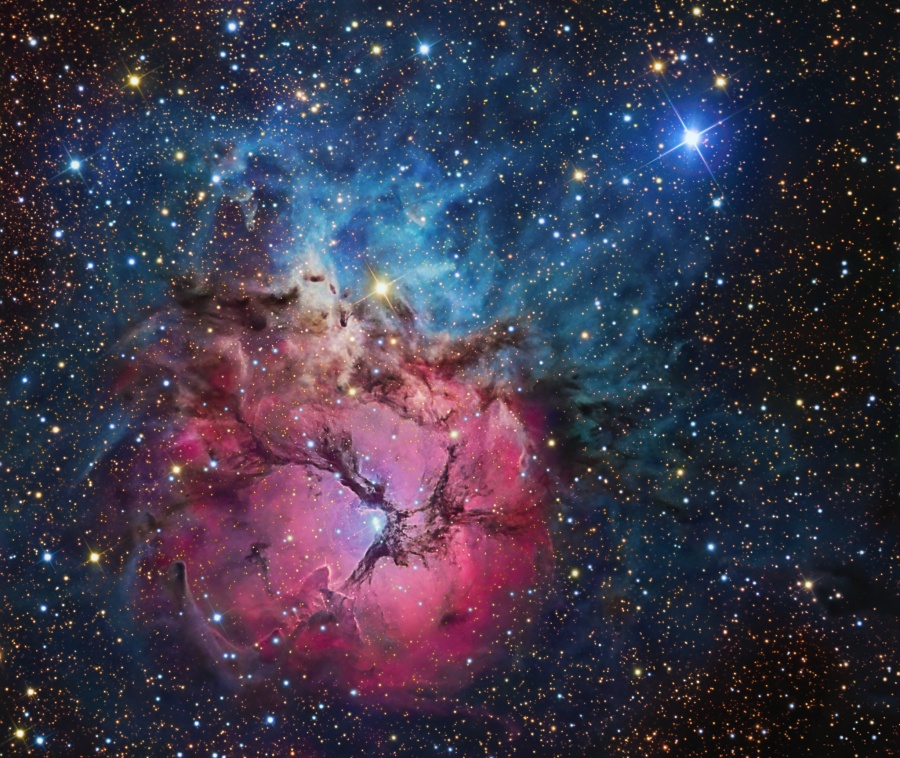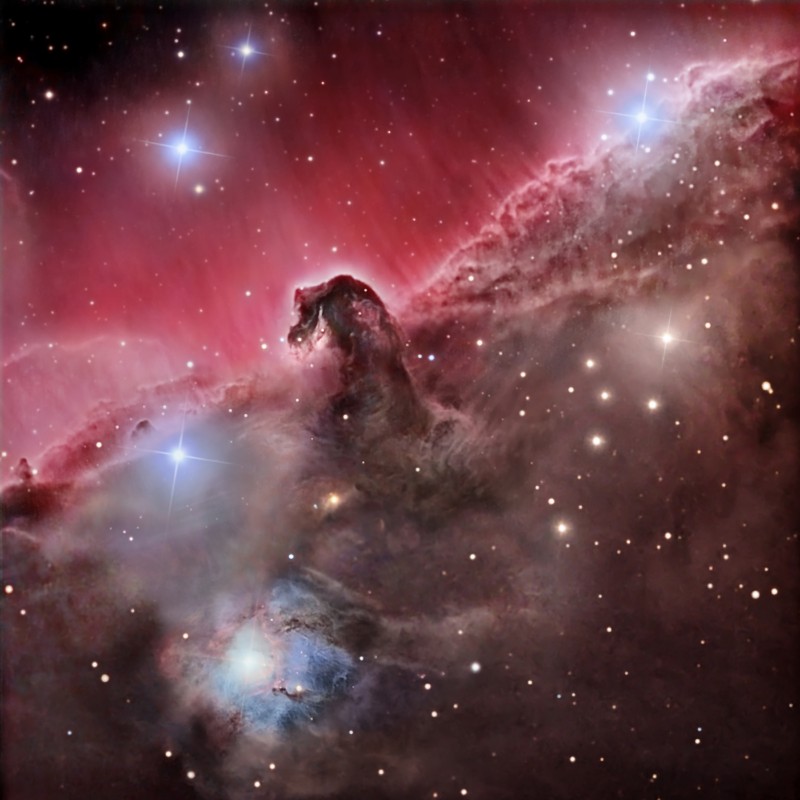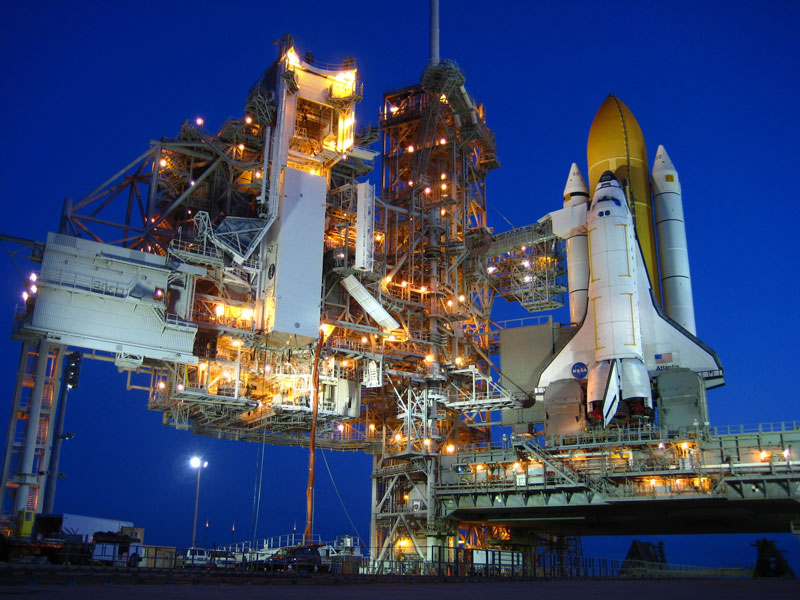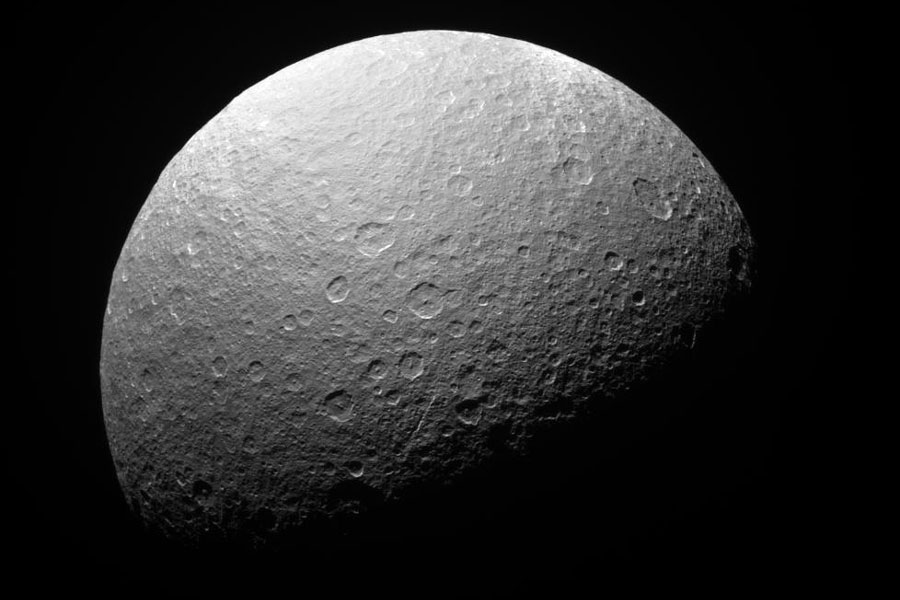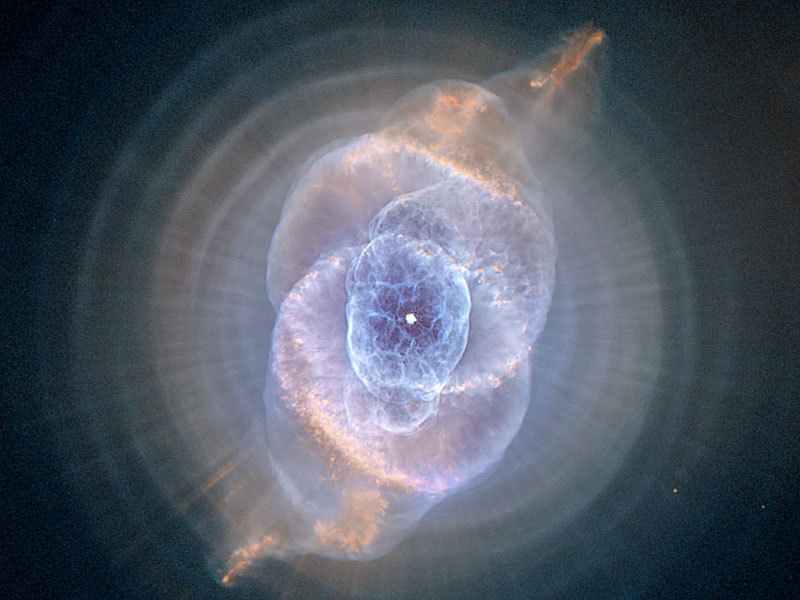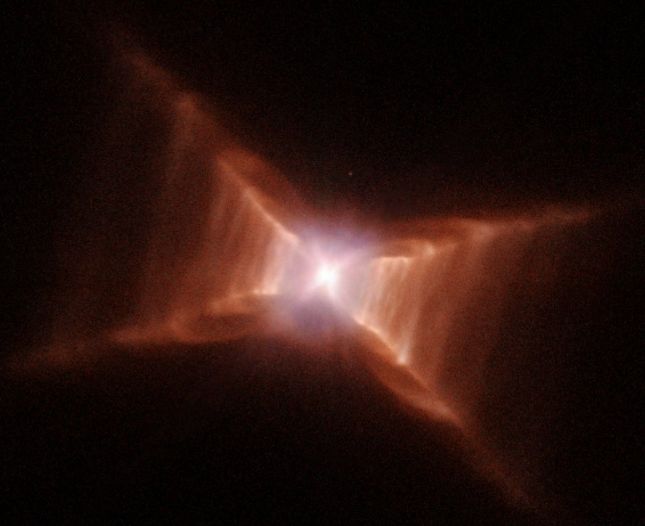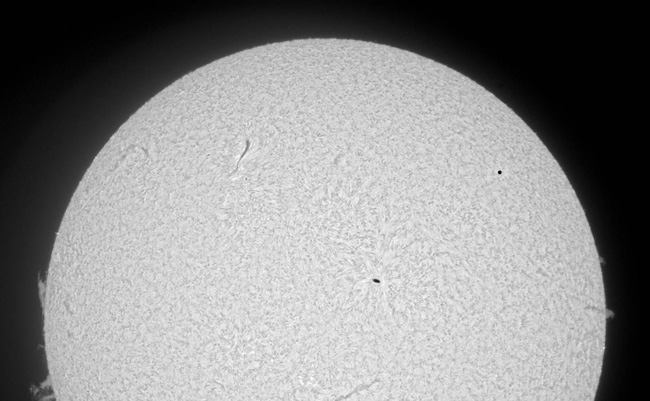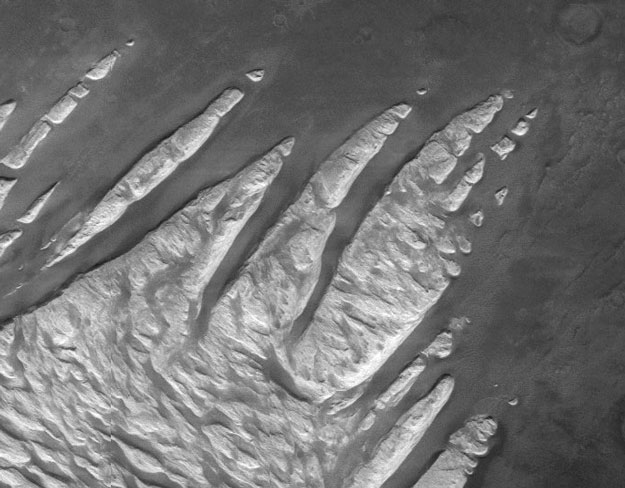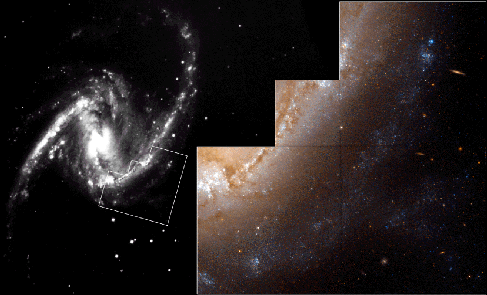| << Previous | Index | Next >> |
2015 Sculpted by stellar winds and radiation, a magnificent interstellar dust cloud by chance has assumed this recognizable shape. Fittingly named the Horsehead Nebula, it is some 1,500 light-years distant, embedded in the vast Orion cloud complex. About five light-years "tall", the dark cloud is cataloged as Barnard 33 and is visible only because its obscuring dust is silhouetted against the glowing red emission nebula IC 434. Stars are forming within the dark cloud. Contrasting blue reflection nebula NGC 2023, surrounding a hot, young star, is at the lower left. The gorgeous featured image combines both narrowband and broadband images.
2014 Can a gas cloud grab a galaxy? It's not even close. The "claw" of this odd looking "creature" in the above photo is a gas cloud known as a cometary globule. This globule, however, has ruptured. Cometary globules are typically characterized by dusty heads and elongated tails. These features cause cometary globules to have visual similarities to comets, but in reality they are very much different. Globules are frequently the birthplaces of stars, and many show very young stars in their heads. The reason for the rupture in the head of this object is not completely known. The galaxy to the left of the globule is huge, very far in the distance, and only placed near CG4 by chance superposition.
2013 It was just eight minutes after sunrise, last week, and already there were four things in front of the Sun. The largest and most notable was Earth's Moon, obscuring a big chunk of the Sun's lower limb as it moved across the solar disk, as viewed from Fremantle, Australia. This was expected as the image was taken during a partial solar eclipse -- an eclipse that left sunlight streaming around all sides of the Moon from some locations. Next, a band of clouds divided the Sun horizontally while showing interesting internal structure vertically. The third intervening body might be considered to be the Earth's atmosphere, as it dimmed the Sun from its higher altitude brightness while density fluctuations caused the Sun's edges to appear to shimmer. Although closest to the photographer, the least expected solar occulter was an airplane. Quite possibly, passengers on both sides of that airplane were contemplating the unusual view only visible out the eastern-facing windows.
2012
2011 The beautiful Trifid Nebula is a cosmic study in colorful contrasts. Also known as M20, it lies about 5,000 light-years away toward the nebula rich constellation Sagittarius. A star forming region in the plane of our galaxy, the Trifid illustrates three different types of astronomical nebulae; red emission nebulae dominated by light emitted by hydrogen atoms, blue reflection nebulae produced by dust reflecting starlight, and dark nebulae where dense dust clouds appear in silhouette. The bright red emission region, roughly separated into three parts by obscuring, dark dust lanes, lends the Trifid its popular name. In this well met scene, the red emission is also juxtaposed with the telltale blue haze of reflection nebulae. Pillars and jets sculpted by newborn stars, below and left of the emission nebula's center, appear in Hubble Space Telescope close-up images of the region. The Trifid Nebula is about 40 light-years across.
2010 Sculpted by stellar winds and radiation, a magnificent interstellar dust cloud by chance has assumed this recognizable shape. Fittingly named the Horsehead Nebula, it is some 1,500 light-years distant, embedded in the vast Orion cloud complex. About five light-years "tall", the dark cloud is cataloged as Barnard 33 and is visible only because its obscuring dust is silhouetted against the glowing red emission nebula IC 434. Stars are forming within the dark cloud. Contrasting blue reflection nebula NGC 2023, surrounding a hot, young star, is at the lower left. The gorgeous color image combines both narrowband and broadband images recorded using three different telescopes.
2009 This shuttle has launched to space. Pictured above, the Space Shuttle Atlantis sat on Launch Pad 39A before dawn last month as it was prepared for the launch. The shuttle orbiter is visible on the image right, attached to a brown liquid fuel tank and two white solid rocket boosters. In the image center is the Fixed Service Structure that stands just over 100 meters tall, including the white lightning rod at the top. Starting on Sunday, the space shuttle embarked on one of its most ambitious missions ever: its fourth mission to fix and upgrade the ageing Hubble Space Telescope. Hubble's replacement, the James Webb Space Telescope, is currently scheduled for launch in 2014.
2008 Saturn's ragged moon Rhea has one of the oldest surfaces known. Estimated as changing little in the past billion years, Rhea shows craters so old they no longer appear round – their edges have become compromised by more recent cratering. Like Earth's Moon, Rhea's rotation is locked on Saturn, and the above image shows part of Rhea's surface that always faces Saturn. Rhea's leading surface is more highly cratered than its trailing surface. Rhea is composed mostly of water-ice but is thought to include about 25 percent rock and metal. The above image was taken by the robot Cassini spacecraft now orbiting Saturn. Cassini swooped past Rhea last month and captured the above image from about 350,000 kilometers away. Rhea spans 1,500 kilometers making it Saturn's second largest moon after Titan. Several surface features on Rhea remain unexplained including large light patches like those seen near the image top.
2007 Staring across interstellar space, the alluring Cat's Eye nebula lies three thousand light-years from Earth. A classic planetary nebula, the Cat's Eye (NGC 6543) represents a final, brief yet glorious phase in the life of a sun-like star. This nebula's dying central star may have produced the simple, outer pattern of dusty concentric shells by shrugging off outer layers in a series of regular convulsions. But the formation of the beautiful, more complex inner structures is not well understood. Seen so clearly in this sharp Hubble Space Telescope image, the truly cosmic eye is over half a light-year across. Of course, gazing into the Cat's Eye, astronomers may well be seeing the fate of our sun, destined to enter its own planetary nebula phase of evolution ... in about 5 billion years.
2006 This false-color mosaic of crumbling comet Schwassmann-Wachmann 3 spans about 6 degrees (12 full moons) along the comet's orbit. Recorded on May 4-6 by an infrared camera on board the Spitzer Space Telescope, the picture captures about 45 of the 60 or more alphabetically cataloged large comet fragments. The brightest fragment at the upper right of the track is Fragment C. Bright Fragment B is below and left of center. Looking for clues to how the comet broke up, Spitzer's infrared view also captures the trail of dust left over as the comet deteriorated during previous passes. Emission from the dust particles warmed by sunlight appears to fill the space along the cometary orbit. The fragments are near their closest approach in the coming days, about 10 million kilometers away, and none pose any danger to our fair planet.
2005 Remember when the Moon was young? It was just last Monday. On May 9th, this slender crescent Moon was recorded at a tender age of 34 hours and 18 minutes. Well, OK ... when calculating the lunar age during a lunation or complete cycle of phases - from New Moon to Full Moon and back to New Moon again - the Moon never gets more than around 29.5 days old. Still, a young Moon can be a rewarding sight, even for casual skygazers, though the slim crescent is relatively faint and only easy to see low in the west as the sky grows dark after sunset. Sighting this young Moon last Monday, lucky astronomer Stefan Seip was also treated to a very dramatic telescopic view of an airliner flying in front of the distant sunlit crescent. At a high altitude, the jet's stunning contrails reflect the strongly reddened light of the Sun setting below the western horizon.
2004
2003 How big is the Sun? The Sun is not only larger than any planet, it is larger than all of the planets put together. The Sun accounts for about 99.9 percent of all the mass in its Solar System. Merely stating the Sun's diameter is about 1,400,000 kilometers does not do it justice. Last week a chance to gain visual size perspective occurred when planet Mercury made a rare crossing in front to Sun. Mercury, a planet over a third of the diameter of our Earth, is the dark dot on the upper right. In comparison to the Sun, Mercury is so small it is initially hard to spot. Also visible on the Sun are dark circular sunspots, bright plages, and dark elongated prominences -- many of which are larger than Mercury. The above contrast-enhanced picture was captured last week from France.
2002 What caused this unusual white rock formation on Mars? Intrigued by the possibility that they could be salt deposits left over as an ancient lakebed dried-up, detailed studies of these fingers now indicate a more mundane origin: volcanic ash. Studying the exact color of the formation indicated the volcanic origin. The light material appears to have eroded away from surrounding area, indicating a very low-density substance consistent with the ash hypothesis. The stark contrast between the rocks and the surrounding sand is compounded by the unusual darkness of the sand. The above picture was taken with the Thermal Emission Imaging System on the Mars Odyssey spacecraft currently orbiting Mars. The image spans about 10 kilometers inside a much larger crater.
2001 One of the more prominent craters on the Moon is named Copernicus. Copernicus is a large young crater visible with binoculars slightly northwest of the center of the Moon's Earth-facing hemisphere. Copernicus is distinguished by its size and by the many bright rays pointing out from it. Although Copernicus is relatively young for a lunar crater, it was formed nearly a billion years ago by a colossal impact. The center of Copernicus is about 93 kilometers across. The above picture was taken in 1972 by the last human mission to the moon: Apollo 17. The prospects for a return have been boosted recently with increased evidence of ice deposits near the lunar poles.
2000 "Safe!" In September 1967 (during regular season play), the Surveyor 5 lander actually slid several feet while making a successful soft landing on the Moon's Mare Tranquillitatis. Equipped with television cameras and soil sampling experiments, the US Surveyor spacecraft were intended to determine if the lunar surface at chosen locations was safe for manned landings. Surveyor 5 touched down on the inside edge of a small crater inclined at about 20 degrees. Its footpad slipped and dug the trench visible in the picture. Covered with dusty lunar soil, the footpad is about 20 inches in diameter.
1999 Dwarfed by Olympus Mons and the other immense shield volcanos on Mars, Apollinaris Patera rises only 3 miles or so into the thin martian atmosphere, but bright water-ice clouds can be still be seen hovering around its summit. Mars' volcanic structures known as "paterae" are not only smaller than its shield volcanos but older as well, with ages estimated to be around 3 billion years. Like Apollinaris Patera, narrow furrows typically extend from their central craters or calderas. It is thought that the paterae represent broad piles of easily eroded volcanic ash. This wide angle view of Apollinaris Patera was recorded last month by the Mars Global Surveyor spacecraft. The large central crater is about 50 miles across.
1998 On April 23, the rising crescent Moon occulted (passed in front of) Venus and Jupiter. The double occultation was a rare event and only visible from certain locations tracing a path across Earth's surface. This dramatic telephoto picture was taken at one such location, Ascension Island in the South Atlantic. The sunlit crescent is over-exposed revealing the rest of the lunar surface illuminated by faint earthshine. Venus is emerging just beyond the crescent's tip and Jupiter is trailing above the dark lunar edge with a spot of light, Jupiter's moon Ganymede, between the lunar limb and the planet's disk. Look closely at Jupiter and you can see yet another Jovian moon, Io, just visible against Jupiter's glare!
1997 The GRB distance scale controversy may have just ended with a flash. Gamma Ray Bursts (GRBs) are powerful explosions occurring in seemingly random positions on the sky. They are so featureless and so poorly resolved, however, that their distances could not be determined. Last Thursday, May 8th, the orbiting Beppo-Sax Satellite detected and precisely located a GRB (GRB970508), quickly relaying its position to astronomers. Within hours, many of the world's most powerful telescopes were re-pointed in the direction of the new GRB. There they found a faint but variable optical source: a potential counterpart to the gamma-ray burst that was getting brighter. Most importantly, continued scrutiny showed that this optical transient had absorption lines with a redshift of about 0.8 - the distance scale of galaxies and quasars. If this source and GRB970508 are related, the GRB itself must be many billions of light-years away and the 30-year controversy on the distance scale to GRBs will draw dramatically to a close. GRBs could move from the realm of astronomical mystery to useful beacons of the early universe. Above is a "negative" image of the GRB970508 field, located near the north celestial pole, taken hours after the initial flash of gamma rays. The faint optical transient source is inside the box. North is up and the image is 2.5 arcminutes across (about a tenth the size of the full moon).
1996 Our Universe is expanding. Distant galaxies appear to recede from us at ever-increasing speeds. What is the rate of expansion? How long has it been expanding? What will be its ultimate fate? Two groups of astronomers are searching vigorously for answers to these fundamental questions using the Hubble Space Telescope (HST). The teams have recently announced conflicting measurements of the Hubble constant, a number which represents the expansion rate of the Universe. Astronomer Wendy Freedman and her collaborators have used pulsating stars called Cepheids to measure the distance to galaxies like the Fornax cluster barred spiral galaxy NGC1365 shown above. The ground based photo (left) shows an inset locating the HST image (right) which Freedman and team have used to identify some 50 Cepheids. Their distance and velocity measurements determine Hubble's constant to be about 80 kilometers per second per megaparsec which means that galaxies one megaparsec (3 million lightyears) distant appear to recede from us at a speed of 80 kilometers per second. Conflicting results indicating a substantially slower expansion rate (smaller Hubble constant) are being reported by astronomer Allan Sandage and collaborators. The value of Hubble's constant was recently the subject of a popular public debate titled "The Scale of the Universe 1996: The Value of Hubble's Constant".
| << Previous | Index | Next >> |




